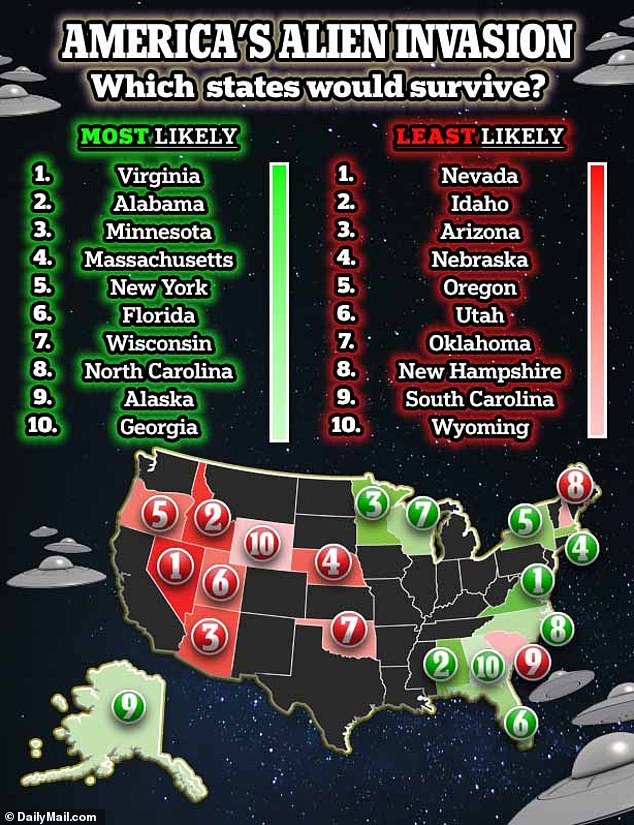A survey has revealed which US states would be the safest places to hide if aliens invaded Earth.
The analysis couldn’t come at a better time, as public concern over the threat of an alien invasion has skyrocketed.
“Gone are the days when it was considered part fringe, part science fiction and part conspiracy theory,” said former UK MoD UFO researcher Nick Pope.
“UFOs are now being treated as a matter of defense and national security, discussed in the United States Congress and attracting the attention of the director of NASA.”
Nearly two-thirds of Americans now believe that extraterrestrials exist, and about a third consider UFO sightings to be proof—a significant increase from 20 percent in 1996.
And Internet searches for ‘what would happen if aliens came to Earth’ have increased 2,850 percent in recent months.
Security officials are also preparing for an extraterrestrial emergency. In June, the first UFO police manual was published, offering guidance to law enforcement on how to respond to unidentified anomalous phenomena.
If you’re wondering where you should flee in case aliens attack, this survey will point you in the right direction.
A survey has revealed which US states would be the safest places to hide if aliens invaded
Rant Casino pulled data on the number of UFO sightings and the average duration of “UFO visits” from the National UFO Reporting Center database and aggregated them by US state.
The number of sightings could suggest that aliens have been hanging around and planning the invasion, and therefore the number and duration of sightings in each state may be related to the odds of an invasion starting there.
Therefore, the states with the fewest UFO sightings were ranked the safest.
Furthermore, one of the first things people should do to survive an alien attack is to hide.
Because of this, Rant Casino decided that states with lower population density may be safer during an invasion, as they would provide more space for people to take cover, evacuate, or organize a counterattack.
This means that rural states or those with large uninhabited regions gained an advantage over more densely populated states.
Each state received a score on the Alien Survival Index scale from zero to 10.
Virginia came out on top as the safest American state to flee to during an alien invasion, with a score of 8.03 out of 10.

The state most likely to survive an alien invasion was Virginia, and the state least likely was Nevada.
This state has the highest per capita military presence in the country, meaning it would be well equipped to defend itself against alien invaders.
Additionally, this state’s landscape features some strong natural defenses, including 29 caves and 63 percent forest cover that could make it easier to conceal the threat from the sky.
Alabama came in second, with a score of 7.9 out of 10.
This state is home to 35 caves and the highest forest cover among the safest states. It also has a strong police presence per capita, which positions it well for coordinated defense efforts.
What’s more, the relatively low rate of UFO sightings in Alabama, at 2.76 per 10,000 residents, suggests that aliens are not looking to this state for a possible invasion.
The rest of the 10 safest states, ranked from safest to least safe, were Minnesota, Massachusetts, New York, Florida, Wisconsin, North Carolina, Alaska and Georgia.
As for the states least likely to survive an alien invasion, it will come as no surprise that Nevada took the number one spot with a score of 5.31 out of 10.
This state, home to the infamous Area 51, has a high rate of UFO sightings of 5.41 per 10,000 residents.
Nevada is also mostly desert. The lack of natural cover and water sources would make it a difficult place to hide if aliens invaded.
Idaho was ranked the second most vulnerable state in part because of its notably high number of UFO sightings: 6.95 per 10,000 residents.
Additionally, this state has the lowest per capita healthcare workforce in the country, which would make it difficult to treat people injured during a violent alien attack.
The rest of the 10 most vulnerable states, ranked in order from most vulnerable to least vulnerable, were Arizona, Nebraska, Oregon, Utah, Oklahoma, New Hampshire, South Carolina and Wyoming.


